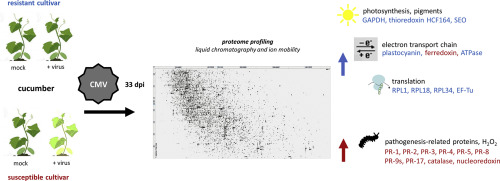当前位置:
X-MOL 学术
›
J. Proteomics
›
论文详情
Our official English website, www.x-mol.net, welcomes your
feedback! (Note: you will need to create a separate account there.)
Cucumber mosaic virus resistance: Comparative proteomics of contrasting Cucumis sativus cultivars after long-term infection.
Journal of Proteomics ( IF 2.8 ) Pub Date : 2019-12-24 , DOI: 10.1016/j.jprot.2019.103626 Slavomíra Nováková 1 , Zdeno Šubr 2 , Andrej Kováč 3 , Ivana Fialová 4 , Gábor Beke 5 , Maksym Danchenko 6
Journal of Proteomics ( IF 2.8 ) Pub Date : 2019-12-24 , DOI: 10.1016/j.jprot.2019.103626 Slavomíra Nováková 1 , Zdeno Šubr 2 , Andrej Kováč 3 , Ivana Fialová 4 , Gábor Beke 5 , Maksym Danchenko 6
Affiliation

|
Plant viruses are a significant threat to a wide range of host species, causing substantial losses in agriculture. Particularly, Cucumber mosaic virus (CMV) evokes severe symptoms, thus dramatically limiting yield. Activation of plant defense reactions is associated with changes in the cellular proteome to ensure virus resistance. Herein, we studied two cultivars of cucumber (Cucumis sativus) resistant host Heliana and susceptible host Vanda. Plant cotyledons were mechanically inoculated with CMV isolate PK1, and systemic leaves were harvested at 33 days post-inoculation. Proteome was profiled by ultrahigh-performance liquid chromatography and comprehensively quantified by ion mobility enhanced mass spectrometry. From 1516 reproducibly quantified proteins using a label-free approach, 133 were differentially abundant among cultivars or treatments by strict statistic and effect size criteria. Pigments and hydrogen peroxide measurements corroborated proteomic findings. Comparison of both cultivars in the uninfected state highlighted more abundant photosynthetic and development-related proteins in resistant cucumber cultivar. Long-term CMV infection caused worse preservation of energy processes and less robust translation in the susceptible cultivar. Contrary, compatible plants had numerous more abundant stress and defense-related proteins. We proposed promising targets for functional validation in transgenic lines: A step toward durable virus resistance in cucurbits and other crops. SIGNIFICANCE: Sustainable production of crops requires an understanding of natural mechanisms of resistance/susceptibility to ubiquitous viral infections. We report original findings of comparative analysis of plant genotypes exposed to CMV. Deep discovery proteomics of resistant and susceptible cucumber cultivars, inoculated with widespread phytovirus, allowed to suggest several novel molecular targets for functional testing in plant protection strategies.
中文翻译:

黄瓜花叶病毒抗性:长期感染后对比的黄瓜黄瓜品种的比较蛋白质组学。
植物病毒是对多种寄主物种的重大威胁,导致农业遭受重大损失。特别地,黄瓜花叶病毒(CMV)引起严重症状,从而极大地限制了产量。植物防御反应的激活与细胞蛋白质组的变化有关,以确保病毒抗性。在这里,我们研究了黄瓜抗性寄主Heliana和易感寄主Vanda的两个品种。用CMV分离物PK1机械接种植物子叶,并在接种后33天收获全身叶片。蛋白质组通过超高效液相色谱进行了分析,并通过离子淌度增强质谱进行了全面定量。使用无标记方法从1516种可重现定量的蛋白质中,根据严格的统计和效应量标准,在不同品种或处理方式中有133个差异丰富。色素和过氧化氢的测定证实了蛋白质组学的发现。比较两个未感染状态的品种,可以看出在抗性黄瓜品种中光合蛋白和发育相关蛋白含量更高。长期CMV感染导致易感品种的能量过程保存能力变差,翻译的鲁棒性降低。相反,相容的植物具有许多更丰富的与胁迫和防御相关的蛋白质。我们为转基因品系的功能验证提出了有希望的目标:在葫芦科植物和其他农作物上实现持久的抗病毒性迈出的一步。意义:作物的可持续生产需要了解对普遍存在的病毒感染的抗性/敏感性的自然机制。我们报告暴露于CMV的植物基因型的比较分析的原始发现。抗性和易感黄瓜品种的深度发现蛋白质组学接种了广泛的植物病毒,可以为植物保护策略中的功能测试提供一些新颖的分子靶标。
更新日期:2019-12-25
中文翻译:

黄瓜花叶病毒抗性:长期感染后对比的黄瓜黄瓜品种的比较蛋白质组学。
植物病毒是对多种寄主物种的重大威胁,导致农业遭受重大损失。特别地,黄瓜花叶病毒(CMV)引起严重症状,从而极大地限制了产量。植物防御反应的激活与细胞蛋白质组的变化有关,以确保病毒抗性。在这里,我们研究了黄瓜抗性寄主Heliana和易感寄主Vanda的两个品种。用CMV分离物PK1机械接种植物子叶,并在接种后33天收获全身叶片。蛋白质组通过超高效液相色谱进行了分析,并通过离子淌度增强质谱进行了全面定量。使用无标记方法从1516种可重现定量的蛋白质中,根据严格的统计和效应量标准,在不同品种或处理方式中有133个差异丰富。色素和过氧化氢的测定证实了蛋白质组学的发现。比较两个未感染状态的品种,可以看出在抗性黄瓜品种中光合蛋白和发育相关蛋白含量更高。长期CMV感染导致易感品种的能量过程保存能力变差,翻译的鲁棒性降低。相反,相容的植物具有许多更丰富的与胁迫和防御相关的蛋白质。我们为转基因品系的功能验证提出了有希望的目标:在葫芦科植物和其他农作物上实现持久的抗病毒性迈出的一步。意义:作物的可持续生产需要了解对普遍存在的病毒感染的抗性/敏感性的自然机制。我们报告暴露于CMV的植物基因型的比较分析的原始发现。抗性和易感黄瓜品种的深度发现蛋白质组学接种了广泛的植物病毒,可以为植物保护策略中的功能测试提供一些新颖的分子靶标。











































 京公网安备 11010802027423号
京公网安备 11010802027423号